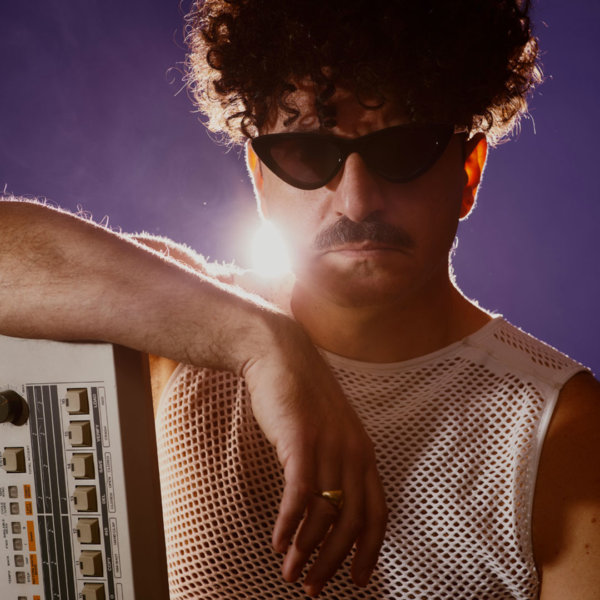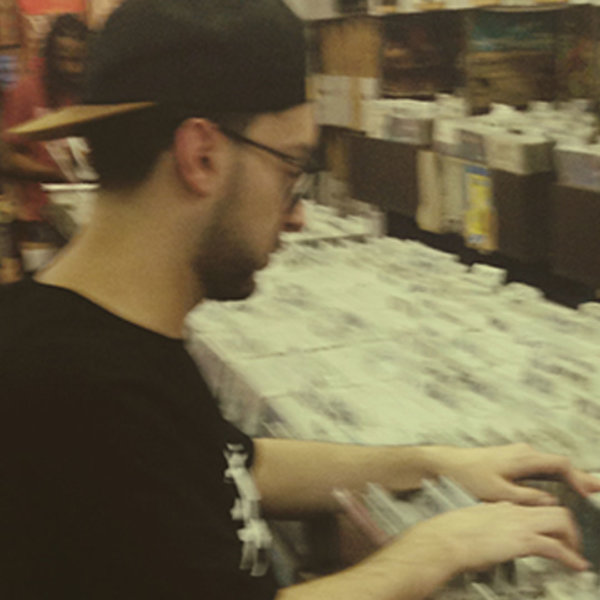Dj Design, bring that beat back! From “Sparkdala” to today’s heat, about making tracks in style.
Dj Design is a man of many talents and well-weighted words. As a DJ, beatmaker, and visual artist from the Bay Area, his name doesn’t ring a major bell to young Hip Hop heads.
In fact, outside the die-hard Quasimoto’s fans and Stones Throw Records‘ early customers, not many people know about how pivotal Keith Griego was in helping Peanut Butter Wolf set up the label’s tone in its early days. Both sonically, and visually.
The aesthetics he brought to the table for some artworks (see below), or the shape of the now-infamous Quasimoto puppet he made originally, are simply contemporary art and relevant contributions to Hip-Hop culture.
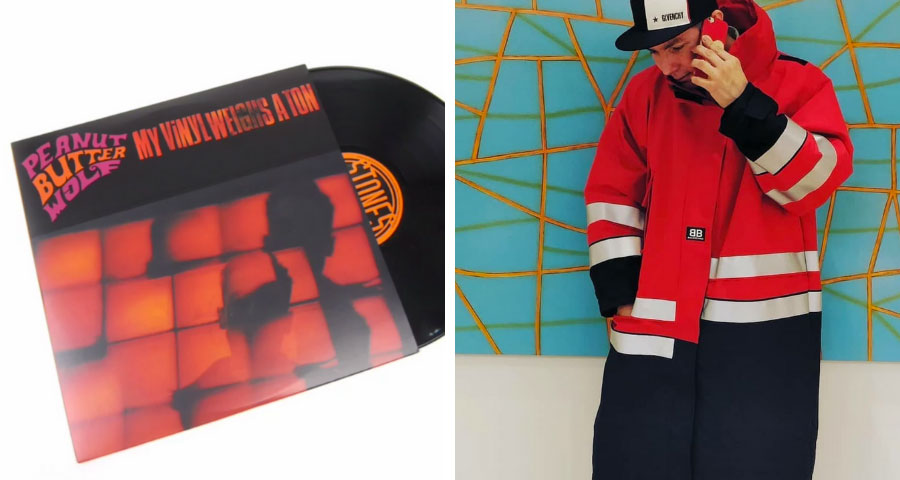
DJ Design, alongside the cover he designed for Peanut Butter Wolf’s release “My Vinyl Weighs a Ton”, 1998
The same man was behind the board for some underground anthems such as What It’s All About, the cut that made Rasco famous overseas and in Europe, for instance. He can also boast that he’s had Lord Quas/Madlib rhyming on one of his beats, for the under-the-influence head-banger Sparkdala!.
As the in-house producer for the outfit known as Foreign Legion, Design has also produced several albums and countless joints. As a true pioneer of the “beat-tape album” genre, you can check his credentials also on “Gather Round”, a very early beat-tape concept published via Stones Throw in 2000.
To this day, after some years of hiatus, Dj Design is still very active, showcasing his latest works on social media. Like a true OG in the beat-making game, he is still producing Hip Hop music using real vintage drum machines and samplers. Let’s dive into his world of sounds, then. Enjoy the reading!
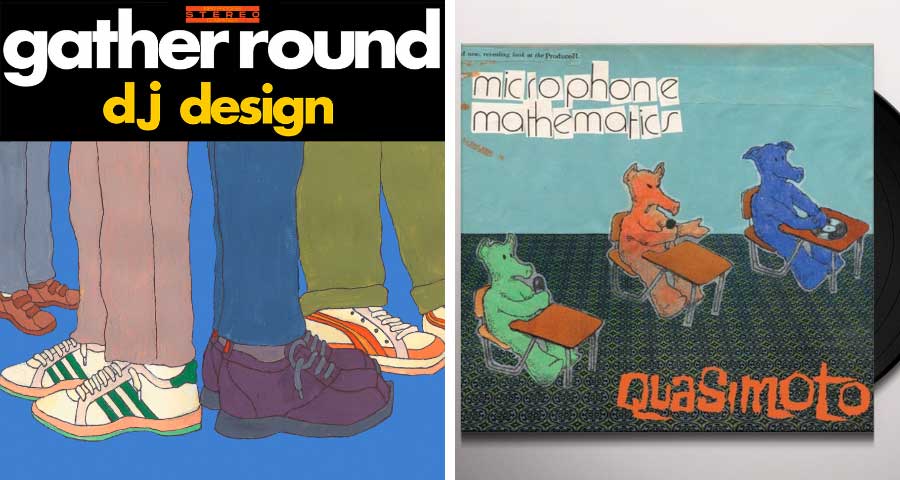
DJ Design’s own drafted debut album cover, and Quasimoto’s cover art, also by Design
Welcome DJ Design, let’s kick this with your early assignments: what was your first commercial beat sold or placed?
It depends on what is meant by the word “commercial“. I’ve done remixes for indie labels, and if I recall correctly the earliest song I remixed was for The Beastie Boys which was only released as an mp3 (that was a new format when it dropped), for a platform called Launch.com. The download was to raise $ for their Kosovo relief effort.
When you began your journey into music production, how long did it take you to produce something that you were proud of?
I actually still have the song and released it much later on my Jetlag album. It was a beat I made on the Ensoniq ASR-10 and was sampled from a folk-psych group called Wendy and Bonnie. I thought my beat sounded like a song because it had some change-ups.
This brings up another point which I hope people could understand. When I was making this sort of music, “beats“, in the 90s people weren’t as acceptable as they are today. When I said to people that “I make beats“, they really had no idea what that meant. People thought DJing and making beats were the same thing. They had no idea it was made on a sampler, they really just didn’t give it thought enough to understand. And now people use the title “beatmaker” in their bios. In the 90s we used to call ourselves “producer” because it sounded more legit.
I’m happy now to be able to say beatmaker proudly. Just look at Gather Round (his first album, ed.), that’s a beat record, not a DJ Shadow-style produced instrumental record. Be proud to make beats. That’s been my motto for most of my life.
We know you as a hardware champion, so this is an easy question: what’s your current favourite production set-up?
My favorite is the E-mu SP-12 paired with the Ensoniq ASR-10. I’ve been using that combo since 1998. But…right now I’m really feeling the SP-12 paired with the Boss SP-202. It sounds amazing and so gritty.
The 202 is so easy to use and then it has great filters. It also saves sounds internally which lets me shut off, take a break and go back to it. An amazing new app was also just released for the SP-12 called the SPL12 (for iOS) which lets you save your beats on the SP12. That’s a game-changer for what I do.

From left to right, Roland TR-707 and TB-303, Boss SP-202 and SP-303 Dr. Rhythm
Always talking about gear, has your equipment changed a lot over the years?
I downgraded from the SP-1200 and the ASR-10 Keyboard to the SP-12 and ASR rack mount. I use them as my main gear. But I recently picked up an AKAI MPC60, and an MPC1000. But I have also been playing with a Roland TR-707. That machine bangs.
It’s so funky and versatile and I’ll be the first to say it, that machine is the funkiest of all the Roland drum machines in my opinion. It has a natural bounce and the drums are strong and poppy. I got the Harry Axten upgrade for it also which turns it into eight different machines in one.
Do you still dig for records to this day? Can you share with us the best digging-related advice received from someone ever?
I do dig but to be honest the biggest advice for me is to make beats not from expensive records but from cheap throwaways. I enjoy finding loops and sounds people have looked over. It’s a scavenger mentality. If you listen to Gather Round, there’s nothing really rare on it but nobody ever made anything like those beats from those records.
Any funny/epic/absurd moments or stories from your digging days?
Not really.
You’ve worked with many incredibly talented artists from the West Coast scene, from the late Nineties to mid-Two-Thou…what do you recall about that time, and how would you describe it to someone who hasn’t lived it back then?
Working with all those people was sort of like having the family you always wanted. We all made beats, some people rapped and we all collected records. We all used similar gear back then, with Ensoniq samplers being the main machine in our crew.
People generally were very helpful and supportive of each other. At the time my closest friend was Peanut Butter Wolf. We had a lot of fun but unfortunately business has a way of ripping relationships apart.
Speaking of the production process, how DJ Design approaches it? Do you have a clear idea in mind, or…?
I think the way I approach music is maybe a little different than a lot of producers. I’m very insecure musically, so in my head, I feel like everything I am working on is just a sketch and so the song gets developed, then I save it make an mp3 and listen to it and dozens of others over and over. I put an acapella to it, then listen again, over and over. Only then I start hearing it as a potential song.
From there I make edits and introduce new sounds, basslines, etc until it becomes a track. Because of this process, I listen to my music about 90% of the time and other people’s music 10%. People ask me what sort of stuff I listen to and I’d have to say mostly my stuff and after that, I listen mainly to producers on IG and YouTube. No one famous, just small producers who make cool stuff.
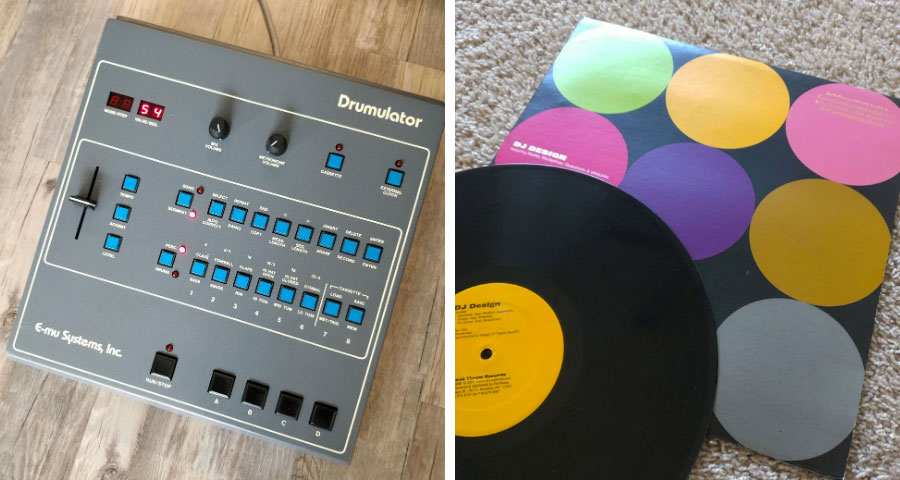
An E-Mu Drumulator machine, alongside a copy of Sparkdala! 12″ promo
Is there any producer out there, in the last three months, that made you say “Oh, sh*t, I have to go back to the lab!”?
Yes definitely. I hear stuff from FredFades on IG. His beats on the SP1200 scare me back to the lab. There’s this guy who goes by H.Potta who makes beats on a Teenage Engineering PO-33. He makes super hot beats too. These are just people that inspire me at the moment.
What do you think is your worst production mistake, if any?
My very worst problem is not saving my sounds properly. I’m getting better but I really need to save ALL of the sounds and not just the samples. I need to save the SP-12 sounds but also a recording of the original sample so I can go back to it. Sometimes I forget where I sampled the beat from. Now I write down the record, the song title so I can reference it back to it if I need to re-sample something.
Can you share an essential mixing tip with us?
When sampling, make sure you EQ the sample exactly for what you want to get from it. If you are sampling a snare, make sure it’s EQ’d so it snaps yet has a little punch. Boost the lows on your kicks, make sure your sample is loud enough. Overdrive the sample when you should.



